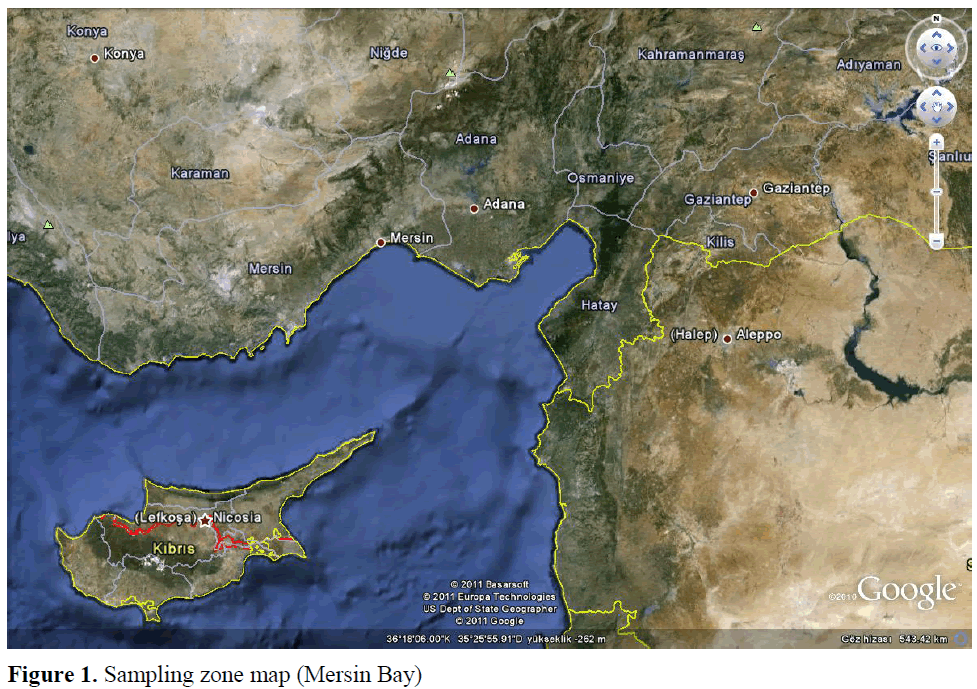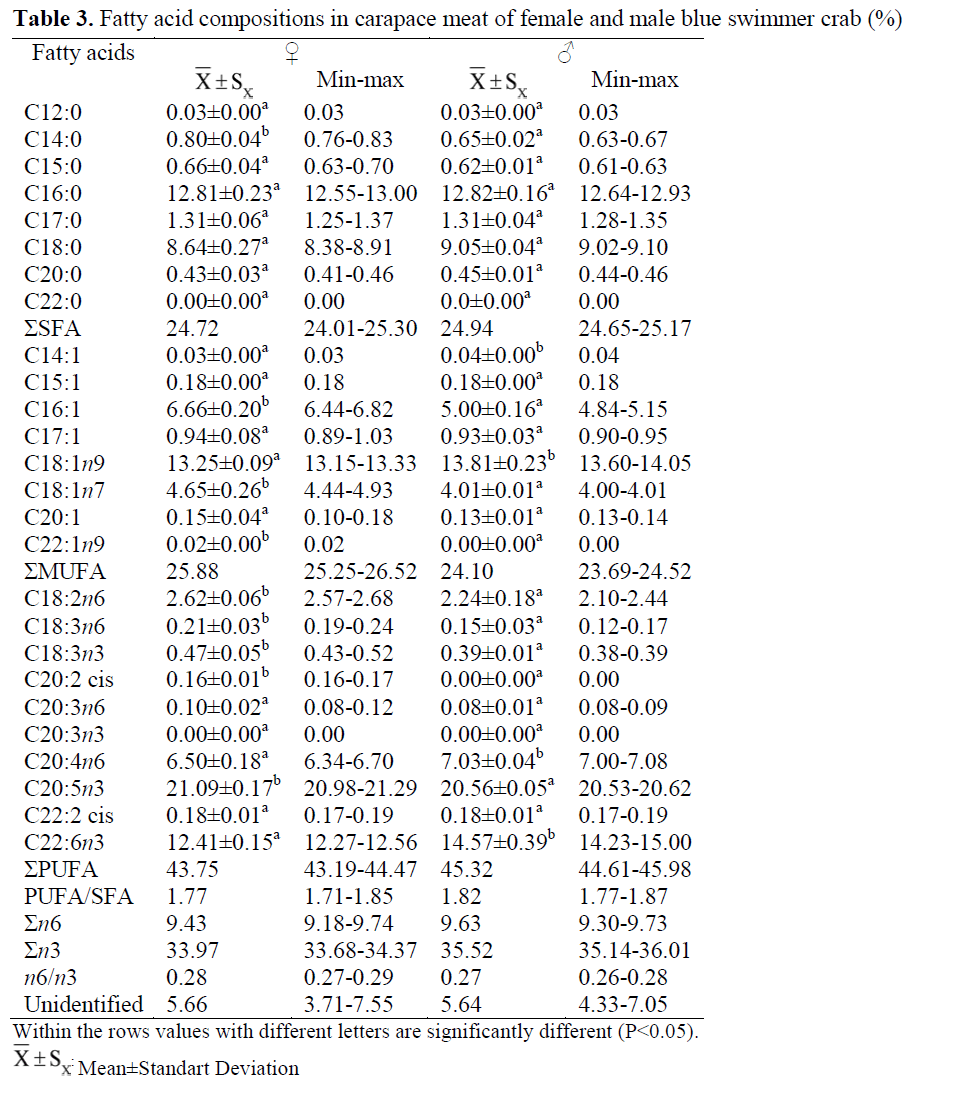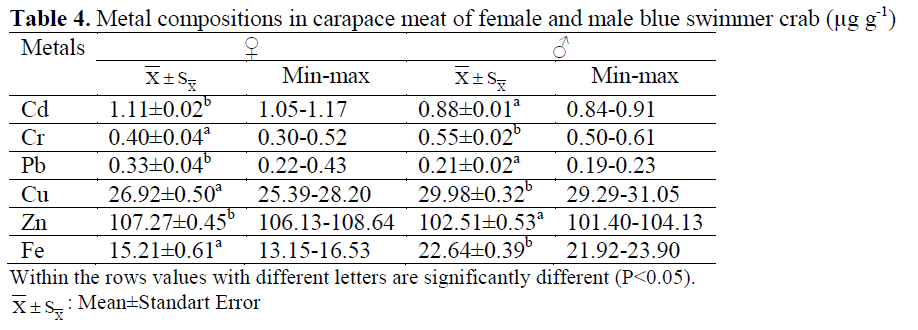Keywords
Blue Swimmer Crab, Portunus pelagicus, Chemical Composition, Sexually mature
Introductions
Blue swimmer crab, Portunus pelagicus, is a large crab found on the coasts of the Indian, Pa-cific and Mediterranean Seas (Razek 1988, Shields and Wood 1993, Göko?lu and Yerlikaya 2003). This big sea crab is an Indio-Pacific spe-cies. This exotic species came to the Mediterra-nean waters after the opening of Suez Canal. Blue swimmer crabs are commonly distributed in the Northeastern Mediterranean shores in Turkey.
Blue swimmer crab is one of crab species which have economic value. Thus, this species is caught both in the world and in Turkey. Ac-cording to Fishstat plus (2010) report, 55 and 95 tons of blue swimmer crabs were caught in 2003 and 2007, respectively in Turkey. On the coasts of Northeastern Mediterranean Sea in Turkey, common big sea crab is the most largely caught species of the Decapods. Although there is a sig-nificant amount of big sea crabs in the Mediter-ranean, in Turkey, the consumption of crab meat is very low but they are generally consumed by European countries.
There are many articles related to the chemi-cal composition of big sea crabs in the various regions of the world (Badawi 1971, Türeli et al. 2000, Al-Mohanna and Subrahmanyam 2001, Skonberg and Perkins 2002, Türeli et al. 2002, Göko?lu and Yerlikaya 2003, Çelik et al. 2004, Naczk et al. 2004, Musaiger and Al-Rumaidh 2005, Hall et al. 2006, Chen et al. 2007, Sudhakar et al. 2009). While blue swimmer crabs contain low levels of lipid, they are rich for pro-tein levels (Türeli et al. 2000, Göko?lu and Yer-likaya 2003, Musaiger and Al-Rumaidh 2005). Göko?lu and Yerlikaya (2003) reported that lipid levels of blue swimmer crabs were less than 1%. In a similar study, Musaiger and Al-Rumaidh (2005) indicated that protein levels of blue swimmer crabs were approximately 20%. Many studies have been done to determine fatty acid composition of big sea crabs (Skonberg and Per-kins 2002, Çelik et al. 2004, Naczk et al. 2004, Hall et al. 2006, Chen et al. 2007, Küley et al. 2007). These studies generally have focused on poly-unsaturated fatty acids. Hall et al. (2006) reported that EPA and DHA levels were ap-proximately 30% of the total lipid for blue swimmer crabs. In a similar study, Küley et al., (2007) indicated that PUFAs were 40-45% of the total lipid for Atlantic blue crabs.
Blue swimmer crab meat contains high levels of Cu, Zn, and Fe (Al-Mohanna and Subrahman-yam 2001, Göko?lu and Yerlikaya 2003). Göko?lu and Yerlikaya (2003) reported that the levels of Cu and Zn of blue swimmer crabs which were caught from Antalya Bay reached to nearly contamination levels. Metal contamination levels for edible tissue of big sea crabs are: The U.S. Food and Drug Administration (USFDA, 2005) sets food contamination levels for crabs (for edi-ble tissue) as 3 μg Cd g-1, 1.5 μg Pb g-1, 12 μg Cr g-1, and these levels are presented as in the fol-lowing by the Turkish Food Codex (2005): 0.5 μg Cd g-1, 0.5 μg Pb g-1, 20 μg Cu g-1 and 50 μg Zn g-1.
Although there are studies on the chemical composition of blue swimmer crabs caught in Antalya and ?skenderun Bays, there is hardly any available information about chemical composi-tion of blue swimmer crabs living in Mersin Bay. Thus, the objective of this study was to determine and compare chemical compositions of male and female sexually mature blue swimmer crabs in Mersin Bay.
Materials and Methods
Materials
Blue swimmer crabs, P. pelagicus, were caught by dip net from Mersin Bay, the coast of Northeastern Mediterranean, in March, 2008 (Figure 1). In the fishing procedure, dip net which had mesh size of 32 mm was used. 30 male and 30 female individuals were caught and kept in polystyrene boxes with ice. When they were brought to the laboratory, they were still alive.

Figure 1: Sampling zone map (Mersin Bay)
Sample preparation
Some morphometric measurements [carapace length (CL), carapace width (CW)] and weight of all samples were done (Table 1). The morpho-metric measurements of crab carapace were done using a calliper. After that, muscle tissues of each sex group including 30 individuals were taken out by hand. All assays were conducted on tripli-cate samples of the homogenates. Chemical com-position analyses were done on these muscle tis-sue samples.

Table 1. Some morphological measurements of male and female blue swimmer crabs
Proximate analysis
Blue swimmer crab samples were analyzed in triplicate for proximate composition. The fol-lowing methods were used: Lipid level by the Bligh and Dyer (1959) method, water level by AOAC (1998a) method, total crude protein by the Kjeldahl method (AOAC, 1998a) and total mineral substance (TMS) level by the AOAC (1998b) method.
Fatty acid analysis
Fatty acid profiles of fat extracted from blue swimmer crab samples were determined by gas chromatography (GC) of methyl esters. Methyl esters were prepared by transmethylation using 2 M KOH in methanol and n-heptane according to the method described by Ichibara et al. (1996) with minor modification. Extracted lipids (10 mg) were dissolved in 2 mL n-heptane followed by 4 mL of 2 M methanolic KOH. The tube was then vortexed for 2 min at room temperature. After centrifugation at 4,000 rpm for 10 min, the heptane layer was taken for GC analyses.
The fatty acid composition was analysed by the GC Clarus 500 with autosampler (Perkin Elmer, Shelton, CT, USA) equipped with a flame ionization detector and a fused silica capillary SGE column (30 m 0.32 mm, ID 0.25 mm, BP20 0.25 UM; SGE Analitic Science Pty Ltd, Victo-ria, Australia). The oven temperature was 140 oC, held for 5 min, raised to 200 oC at a rate of 4 oC/min and to 220 oC at a rate of 1 oC/min, while the injector and the detector temperature were set at 220 oC and 280 oC, respectively. The sample size was 1 μL and the carrier gas was controlled at 16 ps. The split used was 1:50. Fatty acids were identified by comparing the retention times of fatty acid methyl esters with a standard 37-component fatty acid methyl ester mixture (cata-log no 18919; Supelco). Tri replicate GC anal-yses were performed and the results were ex-pressed in GC area % as the mean value ±standard deviation.
Metal analysis
The crab carapace meat samples used for metal analysis were dried at 105°C to reach con-stant weights, and then concentrated nitric acid and percholoric acid (2:1 v/v) were added to the samples, and they were put on a hot plate set to 150°C until all tissues were dissolved (Canl? and Atl? 2003). All blue swimmer crab meat samples were analyzed with ICP-AES. The analyses were performed at least in triplicate.
Statistical analysis
Statistical analysis of data was carried out with the SPSS 16.0. T-test was used to evaluate the effects of sex on the chemical compositions of carapace meat of blue swimmer crabs.
Results and Discussion
Table 1 shows some morphological measure-ments of male and female blue swimmer crabs.
The mean carapace width (CW) was 172.8-183.0 mm for blue swimmer crabs (Table 1). In a study carried out by Razek (1988) in coast of Egypt, male and female blue swimmer crabs (P.pelagicus) with the CW over 90-100 mm were accepted as adults. In a similar study carried out in Kakinada region of India, Devi (1985) ac-cepted male and female blue swimmer crabs (P.pelagicus) with the CW over 95 mm as adults. Thus, according to the results of these studies, male and female blue swimmer crabs used in our study were adults.
Proximate composition
Table 2 shows sexual variation in the proxi-mate composition of carapace meat of blue swimmer crabs.

Table 2. Proximate compositions in carapace meat of male and female blue swimmer crab (%)
Protein levels of female blue swimmer crabs were significantly higher (P<0.05) than those found in male blue swimmer crabs. Lipid, water, and TMS levels of male blue swimmer crabs were significantly higher (P<0.05) than those found in female blue swimmer crabs.
The results indicate that, blue swimmer crabs caught from the Gulf of Mersin have high protein and low lipid levels. These results are supported by findings of the other researchers (Türeli et al. 2000, Göko?lu and Yerlikaya 2003, Musaiger and Al-Rumaidh 2005). In this study, it was found out that protein and lipid levels of blue swimmer crabs were 20.75%-23.44% and 1.13%-1.43%, respectively. Musaiger and Al-Rumaidh (2005) indicate that protein and lipid levels were 19.80%, 0.60%-0.80% in carapace meat of blue swimmer crabs, respectively. In a similar study, Göko?lu and Yerlikaya (2003) reported that pro-tein and lipid levels were 21.5%-22.6%, 0.8%-1.2% for blue swimmer crabs caught from the Gulf of Antalya, respectively. Musaiger and Al-Rumaidh (2005), Göko?lu and Yerlikaya (2004) also reported that the values of protein and lipid in carapace meat of blue swimmer crabs were similar to our study.
Fatty acids composition
Fatty acids, SFAs, MUFAs, PUFAs, PUFA/SFA, n-3 acids, n-6 acids and the n-6/n-3 ratio of male and female blue swimmer crabs’ meat are presented in Tables 3.

Table 3. Fatty acid compositions in carapace meat of female and male blue swimmer crab (%)
The highest proportions of fatty acids in blue swimmer crabs’ carapace meat were palmitic acid (C16:0), heptadecanoic acid (C17:0), stearic acid (C18:0), palmitoleic (C16:1), oleic acid (C18:1 n-9, cis-9-octadecenoic acid), cis-7-octa-decenoic acid, (C18:1 n-7), linoleic acid (C18:2 n-6), arachidonic acid (C20:4 n-6), cis-5,8,11,14,17-eicosapentaenoic acid (EPA, C20:5 n-3) and cis-4,7,10,13,16,19-docosahexaenoic acid (DHA, C22:6 n-3). These results are sup-ported by the findings of Hall et al. (2006).
The results of fatty acid composition indicated that blue swimmer crabs’ carapace meat is very rich in n-3 fatty acids (EPA and DHA). SFAs, MUFAs, PUFAs levels were found as 24.01%-25.30%, 23.69%-26.52% and 43.19-45.98%, re-spectively. The major saturated fatty acids were palmitic acid (12.81% for female, 12.82% for male) and stearic acid (8.64% for female, 9.05% for male). Statically, there were no significant differences in these saturated fatty acids levels in carapace meat of female and male blue swimmer crabs (p>0.05). Palmitoleic acid (4.84%-6.82%) and oleic acid (13.15%-14.05%) were the major MUFAs in blue swimmer crabs’ carapace meat, followed by cis-7-octadecenoic acid (4.00%- 4.93%). Significant differences were indicated in terms of palmitoleic acid, oleic acid, and cis-7-octadecenoic acid between female and male blue swimmer crabs’ carapace meat (p<0.05). There were statistically significant differences (p<0.05) in EPA and DHA -the major PUFAs- levels in female and male blue swimmer crabs’ carapace meat. The proportions of n-3 PUFAs (ranging from 33.68% to 36.01%) were higher than those of n-6 PUFAs (ranging from 9.18% to 9.74%). The UK Department of Health recommends an ideal ratio of n-6/n-3 of 4.0 as a maximum (HMSO 1994) value. Values higher than the maximum value are harmful to health and may promote cardiovascular diseases (Moreira et al., 2001). In this study, the ratio n-6/n-3 was found to range from 0.26 to 0.29. A minimum value of PUFA/SFA ratio recommended is 0.45 (HMSO 1994), which was lower than those obtained from this study.
Metal contents
Table 4 shows sexual variation in metal levels of carapace meat of blue swimmer crab.

Table 4. Metal compositions in carapace meat of female and male blue swimmer crab (μg g-1)
It was also found out that they were rich in metal content, especially Cu and Zn. Cr, Cu, Fe contents of male blue swimmer crabs’ carapace meat were significantly higher (p<0.05) than those found in female blue swimmer crabs’ cara-pace meat while Cd, Pb, and Zn levels were lower (p<0.05). Göko?lu and Yerlikaya (2003) found out that Zn, Fe and Cu levels of blue swimmer crabs were 37.2-46.8 μg g-1, 4.5-6.8 μg g-1, and 14.9-20.8 μg g-1, respectively. The metal levels reported by the researchers were lower than those obtained in our study. This difference might have been caused by the regional differ-ences, sexual maturation and size of individuals. In a similar study, Al-Mohanna and Subrahman-yam (2001) indicated that Cr, Cu, Pb, Zn, levels of female and male blue swimmer crabs’ cara-pace meat were 0.15-0.62 μg g-1, 110.15-142.80 μg g-1, 1.72-2.08 μg g-1 and 188.69-228.68 μg g-1, respectively. Metal levels of blue swimmer crab species found in this study were higher than those found in our study. Metal pollution levels in the Gulf of Mersin and Kuwait Bay might have af-fected these values.
The U.S. Food and Drug Administration (2005) sets food contamination levels for crabs (for edible tissue) as 3 μg Cd g-1, 1.5 μg Pb g-1, 12 μg Cr g-1, and these levels are presented as in the following by the Turkish Food Codex (2005): 0.5 μg Cd g-1, 0.5 μg Pb g-1, 20 μg Cu g-1 and 50 μg Zn g-1. However, our study reveals that Cu and Zn levels are higher than those given above.
Conclusion
In this study, the results showed that the cara-pace meat of male and female crabs were rich in fatty acid (especially EPA and DHA), protein and trace metals. The results also indicated that the blue swimmer crabs, Portunus pelagicus, caught from Mersin Bay, were contaminated with Cu and Zn metals.
714
References
- Al-Mohanna, S.Y., Subrahmanyam, M.N.V., (2001). Flux of heavy metal accumulation in various organs of the intertidal marine blue crab, Portunus pelagicus (L.) from the Ku-wait coast after the Gulf War, Environment International, 27 : 321-326. doi:10.1016/S0160-4120(01)00063-0
- nAOAC., (1998a). Official method 955.04. Nitro-gen (total) in seafood. Fish and other marine products. In: Hungerford JM, chapter editor; Cunniff P, editor. Official methods of analy-sis of AOAC International.chapter 35, p. 6. Arlington, WA
- nAOAC., (1998b). Official method 938.08. Ash of seafood. Fish and other marine products. In: Hungerford JM, chapter editor; Cunniff P, editor. Official methods of analysis of AOAC International. chapter 35, p. 6. Gaithersburg, Maryland
- nBadawi, H.K., (1971). On the chemical composi-tion of the red crab Portunus pelagicus, Ma-rine Biology, 11 : 198-200. doi:10.1007/BF00401267
- nBligh, E.G., Dyer, W.J., (1959). A rapid method of total lipid extraction and purification, Bi-ochemistry and Cell Biology, 37 (8): 911-917. doi:10.1139/o59-099
- nCanli M, Atli G., (2003). The relationships be-tween heavy metal (Cd, Cr, Cu, Fe, Pb, Zn) levels and the size of six Mediterranean fish species, Environmental Pollution, 121 : 129-136
- nÇelik, M., Türeli, C., Çelik, M., Yanar, Y., Er-dem, Ü., Küçükgülmez, A., (2004). Fatty acid composition of the blue crab (Callinectes sapidus Rathbun, 1896) in the north eastern Mediterranean, Food Chemis-try, 88 : 271-273
- nChen, D., Zhang, M., Shrestha, S., (2007). Com-positional characteristics and nutritional quality of Chinese mitten crab (Eriocheir sinensis), Food Chemistry, 103 : 1343-1349. doi:10.1016/j.foodchem.2006.10.047
- nDevi, S.L., (1985). The fishery and biology of crabs of Kakinada region, Indian Journal of Fisheries, 32 : 18-32
- nFisheries Statistics (07.07.2010). State Institute of Statistics Prime Ministry Republic of Turkey, p.2-4, Ankara
- nFishstat plus (04.01.2010). Food and Agriculture Organization of the United Nations, Fisher-ies and Aquaculture Department, Soft-ware,https://www.fao.org/fishery/statistics/software/en
- nGökoglu, N., Yerlikaya, P., (2003). Determina-tion of proximate composition and mineral contents of blue crab (Callinectes sapidus) and swim crab (Portunus pelagicus) caught off the Gulf of Antalya, Food Chemistry, 80 : 495-498. doi:10.1016/S0308-8146(02)00318-7
- nHall, D., Lee, S.Y., Meziane, T., (2006). Fatty acids as trophic tracer in an experimental estuarine food chain: Tracer transfer, Jour-nal of Experimental Marine Biology and Ecology, 336 : 42-53
- nHMSO, 1994. Nutritional aspects of cardiovas-cular disease. Report on health and social subjects no. 46. London: HMSO
- nIchibara, K., Shibahara, A., Yamamoto, K., Na-kayama, T., (1996). An improved method for rapid analysis of the fatty acids of glyc-erolipids, Lipids, 31 : 535-539. doi:10.1007/BF02522648
- nKüley, E., Ozogul, F., Ozogul, Y., Olgunoglu, A.I., (2007). Comparison of fatty acid and proximate compositions of the body and claw of male and female blue crabs (Callinectes sapidus) from different regions of the Mediterranean coast, International Journal of Food Sciences and Nutrition, 1 : 1-8
- nMoreira A.B., Visentainer J.V., De Souza N.E., Matsushita M., (2001). Fatty acids profile and cholesterol contents of three Brazilian Brycon Freshwater fishes, Journal of Food Composition and Analysis, 14 : 565-574. doi:10.1006/jfca.2001.1025
- nMusaiger, A.O., Al-Rumaidh, M.J., (2005). Proximate and mineral composition of crab meat consumed in Bahrain, International Journal of Food Sciences and Nutrition, 56 (4): 231-235
- nNaczk, M., Williams, J., Brennan, K., Liyana-pathirana, C., Shahidi, F., (2004). Composi-tional characteristics of green crab (Carcinus maenas), Food Chemistry, 88 : 429-434. doi:10.1016/j.foodchem.2004.01.056
- nRazek, F.A.A., (1988). Some biological studies on the Egyptian crab Portunus pelagicus (Linnaeus, 1766), Acta Adriatica, 29 : 133-144
- nShields, J.D., Wood, F.E.I., (1993). Impact of parasites on the reproduction and fecundity of the blue sand crab Portunus pelagicus from Moreton Bay, Australia, Marine ecol-ogy Progress Series, 92 : 159-170. doi:10.3354/meps092159
- nSkonberg, D.I., Perkins, B.L., (2002). Nutrient composition of green crab (Carcinus mae-nas) leg meat and claw meat, Food Chemis-try, 77 : 401-404
- nSudhakar, M., Manivannan, K., Soundrapandian, P., (2009). Nutritive value of hard and soft shell crabs of Portunus sanguinolentus, In-ternational Journal of Animal and Veteri-nary Advances, 1 (2): 44-48
- nTurkish Food Codex, (2005). Kabuklular ve yu-musakçalarda (kafadan bacaklilar, karindan bacaklilar) kimyasal, mikrobiyolojik ve or-ganoleptik kabul edilebilir degerler, Ek-8 p.26-28, Ankara
- nTüreli, C., Çelik, M., Erdem, Ü., (2000). Isken-derun Körfez’indeki mavi yengeç (Calli-nectes sapidus Rathbun, 1896) ve kum yengeçlerin (Portunus pelgicus Linne, 1758)’de et kompozisyonu ile verimin arastirilmasi, Turkish Journal of Veterinary and Animal Sciences, 24 : 195-203
- nTüreli, C., Erdem, Ü., Çelik, M., (2002). Kuzey Dogu Akdeniz, Iskenderun Körfezi’nde bulunan mavi yengeç (Callinectes sapidusRATHBUN, 1896)’in et kompozisyonu ve mevsimsel degisimi, Turkish Journal of Vet-erinary and Animal Sciences, 26 : 1435-1439,
- nU.S. Food and Drug Administration (USFDA, 2005) National shellfish sanitation program guide for the control of molluscan shellfish. Guidance documents chapter II. 21.08.2007, pp.1-4 US Food and Drug Administration, Maryland.











